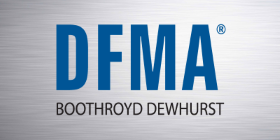John Deere Harvests Savings with DFMA
New EPA-certified Tier 3 engine prompts cost-effective redesign
Manufacturers of offroad vehicles have been meeting increasingly stringent emissions standards for the past several years, and Deere & Company is no exception. Starting in 2006, in particular, Tier 3 regulations from the Environmental Protection Agency require specific reductions of oxides of nitrogen in nonroad diesel engines. Deere has developed a family of new EPA-certified Tier 3 engines for use in its range of offroad equipment.
In the case of one combine harvester, fitting surrounding components to a new Tier 3 engine led Deere engineers and two of the company’s suppliers along a path of intensive cost analysis and redesign. The Tier 3 engine was a different size than the previous engine, so modifications to the basic combine platform were needed.
A major assembly slated for redesign was the swingout landing deck, which has an integrated ladder that provides access to the combine during maintenance. The entire device swivels from the side or rear of the combine at a height of about 6 feet from the ground. The service person can then pull out the ladder, climb up several steps to the secure footing of the landing deck, and attend to equipment maintenance.
Because of the change in engine size, the new landing deck assembly had to be larger. The engineers also wanted to increase the structural rigidity of the assembly at the least possible extra cost without adding weight. As work on the new design progressed, the Deere team identified some cost challenges. First of all, estimates showed that the redesigned assembly would come in at 8 percent above target cost. Second, and of more concern, the supplier quote for the redesigned assembly was 26 percent higher than target.
Deere tackled the cost issues using Design for Manufacture and Assembly (DFMA®) software from Boothroyd Dewhurst, Inc. (Wakefield, R.I.). The software helped them analyze the design for the landing deck and simplify the assembly to save cost. DFMA brainstorming sessions with design and manufacturing engineers, supply management, and suppliers responsible for fabricating and assembling the landing deck yielded 83 design improvement ideas.
“We selected the landing deck for DFMA analysis because we had to take cost out of the design without affecting its integrity, and the software helps us determine how to do that,” says Matt Saxton, cost management specialist at Deere. “We also used the DFMA process to elicit cost-reduction suggestions from suppliers and get them engaged with our design team. We have a system that rewards suppliers for being cost-conscious. A lot of times they’ll tell us how we can reduce their costs by changing something in our design.”
In their redesign work, Deere focused on three tactics:
Shorten the deck sheet. The landing deck sheet is a section of perforated metal flooring that personnel stand on while servicing the combine. A decision to shorten the deck sheet meant Deere could get lengths of steel flooring more economically from a standard-size sheet. “We went to a sheet size that was less expensive to begin with and saved dollars per pound,” says Saxton. “Plus we utilized the sheet much better. Better raw material cost and less scrap represent a two-for-one benefit.” Changing the size of the deck sheet reduced raw material cost by 60 percent.
Strengthen structural support. In the previous design, fabricated C channel provided the assembly with internal structural support. The design team decided to use rectangular steel tubes as support members instead. This saved cost by eliminating a metalforming step and achieved more structural rigidity at less weight. “Weight reduction was a good customer benefit,” says Saxton. “Less effort is required to pull the landing out from the side of the combine, and a lighter machine uses less energy during operation. Any reduction in weight helps manage the use of engine horsepower.”
Replace the ladder rails. In the concept design, the siderails for the pullout ladder were made from round steel tubes. After some investigation, the design team discovered that changing the geometry from round to rectangular tubes would gain them structural support at lighter weight, reduce the manufacturing operations required for mating parts, and reduce cost. With input from their supplier, they also pared 3mm from the tube length, which allowed three sections of tube to be cut from a standard 20-foot length.
The cost harvest for Deere paid off. The original 17-part ladder is now a streamlined 10-part assembly, and the engineering team beat their original target cost by 7 percent for the entire landing deck. Saxton is gearing up for other cost-reduction projects coming down the line. “I just saw a request for a cost review related to the 2008 production timeframe,” he says. “We’ll use DFMA to keep asking the right questions.”
Rear view of a Deere combine harvester, showing the swingout landing deck. The pullout ladder provides service access to the combine during maintenance. Deere engineers modified the landing deck assembly to accommodate the company’s new EPA-certified Tier 3 engine. Design for Manufacture and Assembly (DFMA®) software from Boothroyd Dewhurst, Inc., helped achieve a cost-effective redesign.
1. Involve the right people on the engineering team and give them the right information
2. Be willing to change the way you think about your designs
3. Use the DFMA process to add discipline and direction to idea generation
4. Include suppliers in the costing process and ask for their input on cost ideas





